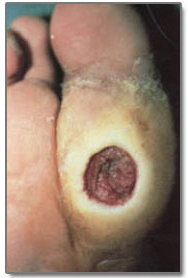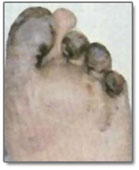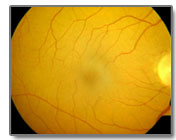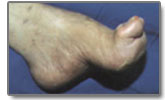Phone:
01322 314765
E-mail address:
info@mptech-services.com
Diabetes mellitus is a disease characterized by absolute or relative inadequacy of Insulin hormone and consequent high blood sugar. Diabetes mellitus is a metabolic cum vascular disorder in which the body’s capacity to utilise glucose, fat and protein is disturbed due to insulin deficiency and/or insulin resistance. This could lead to damage of blood vessels if left uncontrolled. In people with diabetes there is insufficient insulin activity in the body. Insulin is a hormone produced by beta cells of islets of Langerhans in the pancreas.
Type 1 Diabetes (Insulin dependent diabetes) : The pancreas does not produce sufficient insulin, due to self destruction of the cells producing insulin.
Type 2 Diabetes (Non Insulin dependent diabetes) : Stress, Obesity, Poor dietary habits, Lack of physical exercise, having bad lipid profile and heredity.
1. Diabetic Foot Ulcers -
Diabetic ulcers are the most common foot injuries leading to lower extremity amputation. The most common risk factors for ulcer formation include diabetic neuropathy, structural foot deformity and peripheral arterial occlusive disease. A careful physical examination, buttressed by monofilament testing for neuropathy and noninvasive testing for arterial insufficiency, can identify patients at risk for foot ulcers and appropriately classify patients who already have ulcers or other diabetic foot complications. Patient education regarding foot hygiene, nail care and proper footwear is crucial to reducing the risk of an injury that can lead to ulcer formation. The risk of lower extremity amputation is 15 to 46 times higher in diabetics than in persons who do not have diabetes mellitus. Furthermore, foot complications are the most frequent reason for hospitalization in patients with diabetes, accounting for up to 25 percent of all diabetic admissions in the west.
Risk factors for foot ulcers -

2. Peripheral Arterial Occlusive Disease -
Peripheral arterial occlusive disease is four times more prevalent in diabetics than in nondiabetics. The arterial occlusion typically involves the tibial and peroneal arteries but spares the dorsalis pedis artery. Smoking, hypertension and hyperlipidemia commonly contribute to the increased prevalence of peripheral arterial occlusive disease in diabetics.

3. Sensory and Autonomic Neuropathy -
Distal symmetric polyneuropathy is perhaps the most common complication affecting the lower extremities of patients with diabetes mellitus. This complication occurs in up to 58 percent of patients with longstanding disease.19 Neuropathy, a major etiologic component of most diabetic ulcerations, is present in more than 82 percent of diabetic patients with foot wounds.4 This lack of protective sensation, combined with unaccommodated foot deformities, exposes patients to undue sudden or repetitive stress that leads to eventual. ulcer formation with a risk of infection and possible amputation
.jpg)
4. Structural Deformity and Limited Joint Mobility -
Foot deformities, which are common in diabetic patients, lead to focal areas of high pressure.
5. Recurrent infections -
They are due to persistent high Glucose level which is a nutrient medium for organisms.
6. Retinopathy -
Loss of vision, blurring, early cataract are all seen in uncontrolled diabetics,Sudden blindness could be caused due to retinal detachment.
Highlights of Diabetic Retinopathy -

7. High lipids and consequent heart problems
8. Risk Factors Leading to Kidney Disease Diabetics -
Note -
Prevention -
Prevention -
Precautions to be followed in diet and life style -
Continue the life style and dietary modifications. Diabetic complications could be arrested by following the above mentioned precautions and modifications in life style.
Prevention of Ulcer Formation -

How to prevent kidney disease in Diabetics -
Treatments -
How to self examine your feet ?
Look for -
Feel your feet with your hands for -
Diet & Diabetes -
Diet is the most important aspect in the treatment of diabetes, but there is no single diabetes diet.. The old idea that Rice should not be taken is a fallacy. All cereals contain the same amount of starch. e.g., rice, wheat, jowar etc. It is the quantity that matters PICTURE. Vegetable proteins like dal, pulses and legumes are better than animal proteins. Combination of cereals and pulses will enhance the protien quality. Mushrooms are low in calorie, but rich in protein.
Fibre rich food are very good in controlling diabetes and for reducing serum cholesterol. Rich sources of natural fibre are whole cereals, pulses like bengal gram, black gram, green gram and green leafy vegetables. Soluble fibres from fenugreek seeds taken either as sprouted or in powder form can be used as a supportive therapy. Intake of saturated fat should be reduced to prevent increase in serum cholesterol. Use vegetable oils in moderation and a mixture of monounsaturated oils like groundnut or gingilly oil and polyunsaturated oils like saffola or Sunola is best.
The intake of total calories is to be reduced by those who are overweight. CHART Food should be distributed into small frequent feeds. Skipping a meal or fasting is not really advisable.
Vegetables that can be taken in unlimited amounts are - Ash gourd, Beans, Bitter gourd, Bottle gourd, Brinjal, Brussels sprouts, Broccoli, Cabbage, Cucumber, Cauliflower, Chow-chow, Cluster beans, Coriander leaves, Cowpea-pod (Karamani), Capsicum, Drumstick, Ginger , Greens (all varieties), Knol khol, Kovai, Ladies finger, Mint, Onions, Papaya (raw), Plantain flower, Plantain stem, Ridge gourd, Snake gourd, Tomato (raw and ripe), Turnip, White Radish.
Carrot, beetroot, peas and double beans can be used in moderation. Potatoes, yam, colocasia and tapioca are better avoided.
Free Foods : Skimmed buttermilk, unsweetened lime/tomato juice, clear soup, pepper water(rasam), vegetable salads like tomatoes, cucumber, onion, white raddish, lettuce and capsicum.
A BOWL OF SALAD 100 gms = 25 Calories
AVOID Sugar, honey, glucose, jam, jaggery, sweets, cakes, pastries, tender coconut water sweetened, soft drinks, banana, mango, jack fruit, custard apple (Sitaphal) and dry fruits, especially if overweight. Apple, orange, sweetlime, papaya, guava, pear, muskmelon and watermelon etc., may be taken in consultation with Diabetologist/Dietitian when blood sugar is under control.
Food items that are equivalent to 200 calories are : 3 Idlies (or) 3 Chappaties (or) 2 Dosas (or) 1-3/4 cups of Rice. (Remember : any one and not all of these)
KEY MESSAGES :
NO FASTING OR FEASTING
AVOID DIRECT SUGAR
RESTRICT CALORIES OF OBESE
USE UNLIMITED AMOUNTS OF LOW CALORIE FOODS
EXERCISE & DIABETES :
Why exercise? 1. Reduces weight 2. Improves blood sugar control 3. Reduces the dose of diabetic medications 4. Improves the quality of life
How often, How much and How long? Clip of a joggers
Time : Exercise should last for at least 30 minutes and go up to one hour if possible. There should be a warm up and cool down period for each session.
Warm up : Prepares body for vigorous activity; helps prevent strains and injuries to muscles. It should last for 5-10 minutes.
Cool down : Helps restore circulation to normal levels, prevents cramps, sore muscles and post-exercise dizziness. This should also last for 5 - 10 minutes.
Choose your exercise : Walking, running, cycling, swimming, playing team games, dancing, jogging, brisk walking, tennis – choose whatever suits your personality, but stick to it. Regularity is more important
Prevention of diabetes : stills and charts
The prevalence of Diabetes Mellitus in the Indian population now ranks first in the world even ahead of China. In the last twenty years there has been a three fold increase in the prevalence of diabetes and today it is estimated that there are over 32 million people with diabetes in India. The problem in diabetes is that very often it is silent. The symptoms of diabetes such as increased thirst and urination, etc., occur only when the diabetes is severe. In early stages it can remain totally asymptomatic. Moreover after 10-15 years duration of diabetes, the prevalence of all diabetes related complications increase markedly. These include Retinopathy leading to blindness, Nephropathy leading to kidney failure, Heart attacks, Gangrene of the feet, Stroke and even less known complications like Impotency, or sexual weakness. Thus diabetes is a serious threat to public health and this shows the urgent need for prevention of diabetes.
I. Primary prevention : chart
Primary prevention refers to the prevention or the postponement of diabetes in those who are susceptible to diabetes. Early detection is the key to prevent and control diabetes. As diabetes is largely asymptomatic, regular screening for diabetes is most important.
Indications for screening :
1. Positive Family History
It is a well known fact that diabetes is caused mostly due to hereditary factors. Hence it is clear that screening of diabetic families would be the first priority.Risk of diabetes :
Hence it is clear that any one who has positive family history should be screened for diabetes.
At what age the screening should be started?
The onset of diabetes is earlier in Indians i.e., around 20-30 years of age. If the family history is strong, e.g., members of more than two generation in the family have diabetes, the first screening could be done even by 20 years of age and thereafter on a yearly or two yearly basis.
2. Obesity
Obesity causes resistance to Insulin. Your body makes insulin but the extra weight prevents it from using the insulin the way it should be used. For this reason, obesity is another risk factor for diabetes.
3. Physical inactivity (those with sedentary jobs)
Which test is to be done?
The Glucose Tolerance Test (GTT) is the confirmatory test since it helps to diagnose even the early stage of diabetes. Most people check only Fasting, Postprandial or Random Blood Sugar which may not reveal diabetes until it is at a more advanced stage. Even if the GTT results show normal values at the time of testing, it does not mean that the person will never develop diabetes. Such individuals should have an annual GTT done if the family history of diabetes is very strong.
II. Secondary Prevention : chart
Secondary Prevention refers to the prevention of complications once diabetes set in. This can be achieved by good control of diabetes with the help of diet, exercise, medication and regular monitoring of blood sugars. Blood sugars can be checked even on daily basis with the help of blood sugar meters which facilitates quick determination of blood sugars. Since blood sugars tend to fluctuate a lot, from day to day or hour to hour, HbA1C (Glycosylated haemoglobin) test should be done to assess the blood sugar for the previous 2-3 months.
III. Tertiary prevention : chart
Tertiary prevention refers to the rehabilitative measures once the complications have set in. For example, for Diabetic Retinopathy, Laser Photocoagulation will help to prevent or reduce the incidence of blindness. Laser photocoagulation helps to seal leaking blood vessels in the retina and thus prevent visual loss. It is recommended that at least once a year every diabetic individual should do a complete check-up of all complications especially the eyes, kidneys, heart and feet in order to reduce the morbidity due to diabetes.
Key Messages :
STILL PICTURE OF PANCREAS
STILL PICTURE OF INSULIN TARGET ACTIONS AND ORGANS
Video of SELF MEDICATION / injection OF INSULIN
Still picture of Glucometer.
IMA House, Shalimar Chowk, Nashik – 422 001.
Copyright IMA All Rights Reserved. Designed & Developed By : Xposure Techmedia Pvt Ltd